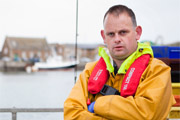 Bord Iascaigh Mhara (BIM), Irish Water Safety (IWS), the statutory body established to promote water safety and the Royal National Lifeboat Institution (RNLI) are continuing their campaign to encourage more fishermen to wear their lifejackets at sea.
Bord Iascaigh Mhara (BIM), Irish Water Safety (IWS), the statutory body established to promote water safety and the Royal National Lifeboat Institution (RNLI) are continuing their campaign to encourage more fishermen to wear their lifejackets at sea.
Image: Noel O’Sullivan, a fisherman for 22 years and a survivor of an accident at sea is acting ambassador for the campaign to appeal directly to his fellow fishermen around the coast.
Despite seven fishermen losing their lives at sea this year to date, a laissez-faire attitude to safety still exists in the industry, particularly in relation to the wearing of lifejackets. In an effort to get fishermen to take notice of the real danger of going to sea without wearing a lifejacket, Noel O’Sullivan, a fisherman from Castletownbere, Co. Cork will act as Ambassador for the campaign. Noel survived an accident at sea, along with his six crew, when his vessel ‘Discovery’ capsized off the Isles of Scilly on the 29th January, 2007.
Noel describes the day of the accident…‘I will never forget that day. As we were hauling in the catch, I knew there was something wrong. She was listing dangerously and I instructed the crew to launch the life rafts and jump overboard. As we jumped, she listed violently and capsized onto one of the life-rafts – puncturing it…..I treaded the freezing water for more than two hours until we were rescued….. I was terrified going back fishing but I went back as it’s my livelihood, it’s what I know…the difference is, I am more aware of the dangers now and I insist all my crew wear lifejackets. I would appeal to all fishermen to do the same’. Hear Noel’s full story
The fatality rate for Irelands fishing sector stands at 88 per 100,000, making it 48 times more hazardous than other occupations*. Wearing a suitable lifejacket is the single most effective measure a fisherman can take to increase the chance of survival if involved in a man-overboard accident at sea.
Jason Whooley, BIM’s CEO appeals to the fishing industry: ‘I am sincerely asking all fishermen to wear their lifejackets. It could be the difference between life and death, it is that simple. Despite being a legal requirement, it is not something that is taken seriously enough in the fishing sector. We aim, along with our partners, IWS and the RNLI, to change this mentality through a targeted and on ongoing safety campaign and I am delighted that Noel, who has personally survived an accident at sea, is helping us to drive this important message home.’
Current RNLI statistics suggest that less than 35% of fishermen regularly wear a lifejacket. Many fishermen feel that wearing a jacket inhibits their mobility and makes working on deck much more difficult. Part of this awareness campaign will be highlighting that there are a growing range of lifejackets that fishermen can use to suit their method of fishing and skippers and crew have a responsibility to themselves, work colleagues and family to consider the available options. In fact, there are new lifejackets on the market that are extremely light and compact and would not interfere with work on deck at all.
BIM are driving the safety campaign through press and regional broadcast and online through their website, facebook, linkedin and Youtube
DON’T BECOME ANOTHER STATISTIC…..RESPECT YOUR LOVED ONES AND WEAR A LIFEJACKET
* According to statistics from the Health & Safety Authority and BIM, the fatal accident rate in the general working population in Ireland over the last five years was 1.8 per 100,000 employed.
 Bord Iascaigh Mhara (BIM), Irish Water Safety (IWS), the statutory body established to promote water safety and the Royal National Lifeboat Institution (RNLI) are continuing their campaign to encourage more fishermen to wear their lifejackets at sea.
Bord Iascaigh Mhara (BIM), Irish Water Safety (IWS), the statutory body established to promote water safety and the Royal National Lifeboat Institution (RNLI) are continuing their campaign to encourage more fishermen to wear their lifejackets at sea. 
 Bord Iascaigh Mhara (BIM), Irish Water Safety (IWS), the statutory body established to promote water safety and the Royal National Lifeboat Institution (RNLI) are continuing their campaign to encourage more fishermen to wear their lifejackets at sea.
Bord Iascaigh Mhara (BIM), Irish Water Safety (IWS), the statutory body established to promote water safety and the Royal National Lifeboat Institution (RNLI) are continuing their campaign to encourage more fishermen to wear their lifejackets at sea. 